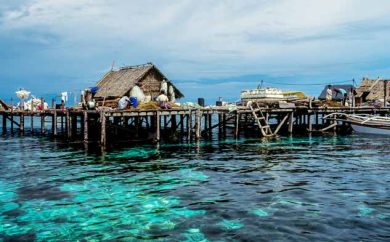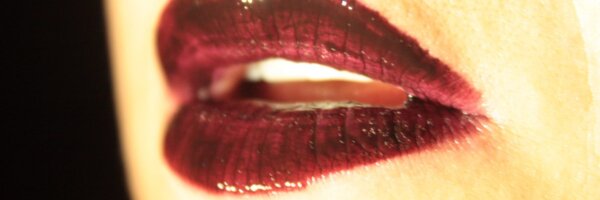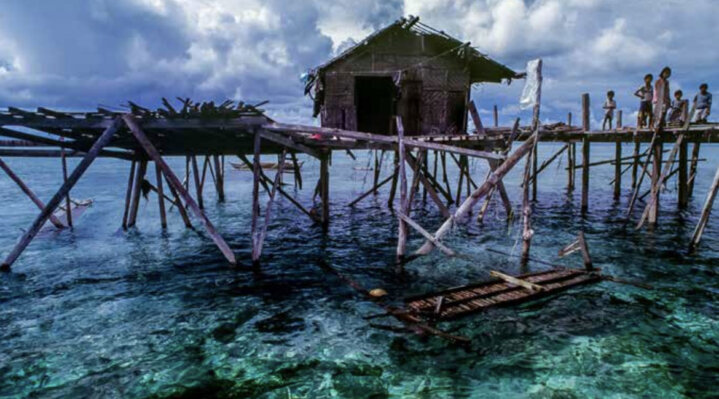
Sea Gypsies
“It amazes me more than anything. Their daily life cycle is so simple.”
Moving smoothly on the ocean that I had always fear to tread and miles away from civilisation is a courageous thing to do especially for someone like me whose fear of open water is quite strong. The dive boat carrying me with my husband and his dive buddies anchor in the middle of the ocean and took a small motorboat to check on the stilt house we see in the distance. As we got nearer the first house, our boatman waves at the sea gypsy and he waved back although lost in reverie.
His nearest neighbour is a mile away and commuting between houses is done by boat or simply walking on the reefs. It blew my mind how a supposedly deep, deep sea has shallow water. Apparently, these shallow areas are the result of hundreds of coral-based islands that have collapsed during storms, typhoons and big waves continuously ravage the corals. The houses are built on stilts on top of these reefs.

The wife of the sea gypsy has a very welcoming voice. We sit in our boat and I started a conversation with her. She says that their main means of livelihood is seaweed farming and it’s not a very easy task. They have to be alert and continuously watch for ecologists and environmentalists as seaweed cultivation is a serious threat to reefs. We found this remote part of the ocean away from the surveillance of authorities to earn a living. Our family has been living in seaweed farming for generations, the woman explains.

The couple has been married for eight years and has three children. They come from a generation of sea gypsies or Badjao a tribal group found in many coastal settlements and inhabit the waters and shores of the Sulu Archipelago. Their ancestors used to ply the Basilan strait for fish, shells and corals. Even before the discovery of the Philippines their ancestors lived in colourful vintas (sailboats) and took shelter in stilt homes during storms.
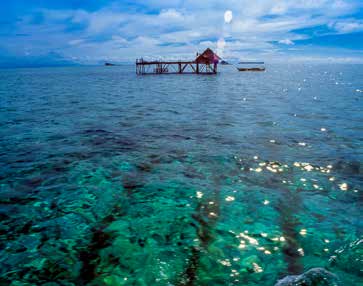
The Gypsy man said it’s very different now. There are no more vintas and a small canoe replaced them. They cultivate two seasons of seaweed then after harvest they move to another reef to repeat the same cycle. The day we met the family, it was overcast and the sun is just breaking through the clouds. The whole family Fatima, Ali and their three children and another relative are outside the porch of their modest home with smiles on their faces.
Looking at them, I am puzzled as how they are able to live the way they do. The entire family all live in this small one room probably measuring 5 square metres with no division for privacy.

It amazes me more than anything. Their daily life cycle is so simple. They wake up before the sun rises in the morning and eat simple breakfast of rice and fish freshly caught and cooked with water and salt and left to dry. They start their day either harvesting seaweed or seeding meaning work for four hours in cold water while the temperature outside soar to nearly 40 degrees Celsius. The children are raised to help in the cultivation and harvest. They are lucky to find themselves in a classroom to at least learn how to read and write.
The women do the regular chores of washing and drying clothes, cooking food while the men gather and spread out the seaweed to let it dry on the porch, continuing the endless chores of sea gypsies. The family make very little money from this. It’s the merchants who come to pick up the harvest and sell it to companies in Japan who profit from this venture.

Seaweed has a lucrative market in Japan as a food additive and a medicine. Boiling the dried seaweed produce a gelatine like substance called carrageenan. It is used for curing leather and as an emulsifying agent in pharmaceuticals, food products, cosmetics and shoe polish. The locals soak it in boiling water and serve it with vinegar, salt, chillies, onion and tomatoes… an appetising salad that prevents goitres. I felt quite strange when we went back to our chartered boat. That night I could not sleep. I missed the family.
The picture of the family in that small place never leaves my mind and I draw a conclusion that it’s possible to feel happy and content living in the middle of nowhere with no guarantee of tomorrow for anyone. In the middle of the night, the ocean gets really rough. From the sound of the waves amid the continuous swaying of the boat, I can sense that the house on stilts might be hit strongly. The whole night we worry about the family.
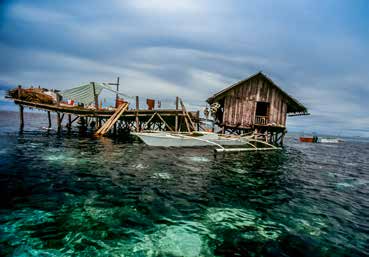
The following day before breakfast, we go back to the reef to check on them. They are all sitting on the steps and smiling totally oblivious to what happened during the night when the strong wind cast its wrath and could have swept them away. I guess it is a normal occurrence and they are so used to it. While I am filled with great wonder by the richness of the reef that can be seen clearly from where I was, a motorised boat arrives to unload three sacks of rice and gallons of oil, payment for the seaweed that has been harvested. I cannot help but be surprised at the obvious happiness on the faces of the whole family.
I feel that the food and a few pesos are not fair compensations for all the hard work in such conditions so far from civilisation. I share a few things with the children and said goodbye knowing my chance of going back is close to nil. As I leave, I feel like I am travelling in time between their world and mine.
